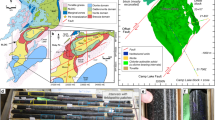Summary
Here we report the first example of a thallium-only deposit, which was discovered in the northeast margin of the Yangtze block, eastern China, in the transition zone between the Yangtze Block, North China Block and Dabie orogenic belt. Ore from the Xiangquan deposit will be mined, ore-dressed and smelted independently for thallium. The ore deposit is hosted in Lower Ordovician micrite, calcilutite and marl within the Dalongwang Mountain Xiao Mountain anticline. The ore zones are fold and fault controlled. Thallium occurs mainly in pyrite but minor amounts form as lorandite (TlAsS2) and hutchinsonite (TlFeS2). Fluid inclusion studies of two stages of fluorite intimately associated with ore-forming pyrite yielded homogenization temperatures of 120 to 220 °C with a salinity of 1.5 to 6.0 equivalent wt.% NaCl. Thallium was originally derived by hydrothermal emanations onto the sea floor and deposited in calcareous sediments. Subsequently in the Early Cretaceous (Yanshanian period) these source beds were reworked to form thallium enriched minerals in hydrothermal veins.
Similar content being viewed by others
References
YF Chang SW Dong (1996) ArticleTitleOn tectonics of “Poly-basement with one cover” in Middle-Lower reaches of Yangtze Craton China. Volcanol Mineral Resources 17 17–25
YF Chang XP Liu YC Wu (1991) The copper-iron belt of the Lower and Middle Reaches of the Changjiang River. Geological Publishing House Beijing 379
DY Chen ZX Zhou (2000) ArticleTitleStudying situation about Lanmuchang type thallium (mercury) ore deposit in southwestern China. Guizhou Geol 17 236–242
Fan Y, Zhou TF, Yuan F (2005) Samarium-neodymium isotope dating of flourites from the Xiangquan thallium deposit (Anhui, China): the first discovery of Yanshanian period epithermal mineralization in northeast margin of the Yangtze block. Chinese Sci Bull (in press)
JA Groff MT Heizler WC Mcintosh DJ Norman (1997) ArticleTitle 40Ar/39Ar dating and mineral paragenesis for Carlin-type gold deposits along the Getchell trend, Nevada: evidence for Cretaceous and Tertiary gold mineralization. Econ Geol 92 601–622 Occurrence Handle10.2113/gsecongeo.92.5.601
BA Hofmann (1994) ArticleTitleFormation of sulfide melt during Alpine metamorphism of the Lengenbach polymetallic sulfide mineralization, Binntal, Switzerland. Mineral Deposita 29 439–442
BA Hofmann MD Knill (1996) ArticleTitleGeochemistry and genesis of the Lengenbach Pb–Zn–As–Tl–Ba mineralisation, Binn Valley, Switzerland. Mineral Deposita 31 319–339
AH Hofstra JS Cline (2000) ArticleTitleCharacteristics and models for Carlin-type gold deposits. SEG Rev 13 163–220
SR Jankovic (1993) ArticleTitleMetallogenic features of the Alsar epithermal Sb–As–Tl–Au deposit (the Serbo-Macedonian metallogenic province). N Jb Mineral Abh 166 25–41
S Jankovic (1989) ArticleTitleSb–As–Tl mineral association in the Mediterranean region. Int Geol Rev 31 262–273 Occurrence Handle10.1080/00206818909465879
RE Krupp TM Seward (1987) ArticleTitleThe Rotokawa geothermal system, New Zealand: an active epithermal gold-depositing environment. Econ Geol 82 1109–1129
YJ Liu LM Cao ZL Li (1984) Element geochemistry. Scientific Publishing House Beijing 392–399
JW Mao S Holly AD Du TF Zhou YX Mei YF Li WS Zang JW Li (2004) ArticleTitleMolybdenite Re-Os precise dating for molybdenite from Cu–Au–Mo deposits in the middle-lower reaches of Yangtze River Belt and its implications for mineralization. Acta Geol Sin 78 121–131
RJ Sobott R Klaes GH Moh (1987) ArticleTitleThallium containing mineral systems. Chem Erde 47 195–218
Wu MA, Tu YJ, Wang XY (2000) Exploration study on gold and silver mineral resources in north Changjiang region. Report, Hefei, pp 1–198 (unpublished)
YS Zhai SZ Yao XD Lin (1992) Iron and copper deposits in the middle and lower reaches of Yangtze River. Geological Publishing House Beijing 1–254
BG Zhang J Hu SX Wang (2000) ArticleTitleGeochemistry and biological mineralization in the thallium deposit in southwest metallogenic zone. Bull Mineral Petrol Geochem 19 341–342
Z Zhang XM Zhang BG Zhang (1998) ArticleTitleElemental geochemistry and metallogenic model of Nanhua As–Tl deposit in Yunnan Province, China. Geochemistry 3 269–275
TF Zhou F Yuan SC Yue Y Zhao (2000) ArticleTitleTwo series of copper-gold deposits in the middle and lower reaches of the Yangtze River area and the O, S, Pb isotopes of their ore-forming hydrothermal systems. Sci China (Series D) 43 IssueIDSuppl 208–218
Zhou TF, Yuan F, Yue SC, Liu XD, Zhang X, Fan Y (2005) Geochemistry and thermodynamic evolution of ore-forming fluids of the Yueshan Cu–Au skarn and vein-type deposits, Anhui Province, China. Ore Geol Rev (in press)
Author information
Authors and Affiliations
Rights and permissions
About this article
Cite this article
Zhou, T., Fan, Y., Yuan, F. et al. A preliminary geological and geochemical study of the Xiangquan thallium deposit, eastern China: the world’s first thallium-only mine. Mineralogy and Petrology 85, 243–251 (2005). https://doi.org/10.1007/s00710-005-0088-2
Received:
Accepted:
Published:
Issue Date:
DOI: https://doi.org/10.1007/s00710-005-0088-2




